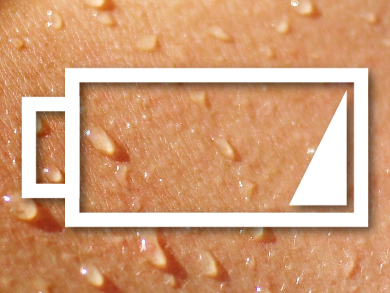The development of wearable electronics hinges on finding replacements for the bulky, rigid, and heavy batteries used today. One possibility to solve this issue are flexible batteries, but such devices often have small capacities and need to be charged frequently. Another approach uses flexible energy sources that harvest energy from the sun, body movement, or even sweat.
Patrick P. Mercier, Sheng Xu, Joseph Wang, University of California, San Diego, La Jolla, USA, and colleagues have developed a flexible biofuel cell that can be applied directly to human skin and which uses the lactate in sweat to generate energy. The team used gold “islands”, connected by stretchable conductive bridges, on a polyimide base to create two electrodes on a single polymer patch. The anode islands were then functionalized with porous carbon nanotube-naphthoquinone (CNT-NQ) structures and the cathode with porous carbon nanotube-silver oxide (CNT-Ag2O) structures. These porous materials allow for a high loading with the fuel cell’s active components, and thus, a high power output.
The anode was coated with the enzyme lactate oxidase (LOx), which can rapidly oxidize the lactate found in sweat. On the cathode side, Ag2O is reduced to silver. The patch was tested by applying it to the arm of a test person during exercise. It was able to power, e.g., a light-emitting diode (LED) or a low-energy Bluetooth device. With physiologically feasible lactate concentrations, the device provides a voltage of 0.5 V and a power density of nearly 1.2 mW cm–2 at 0.2 V. According to the researchers, this is the highest power density for a wearable biofuel cell to date.
- Soft, stretchable, high power density electronic skin-based biofuel cells for scavenging energy from human sweat,
Amay Bandodkar, Jung-Min You, Nam-Heon Kim, Yue Gu, Rajan Kumar, Vinu Mohan A. M., Jonas Felipe Kurniawan, Somayeh Imani, Tatsuo Nakagawa, Brianna Parish, Mukunth Parthasarathy, Patrick Mercier, Sheng Xu, Joseph Wang,
Energy Environ. Sci. 2017.
DOI: 10.1039/c7ee00865a



